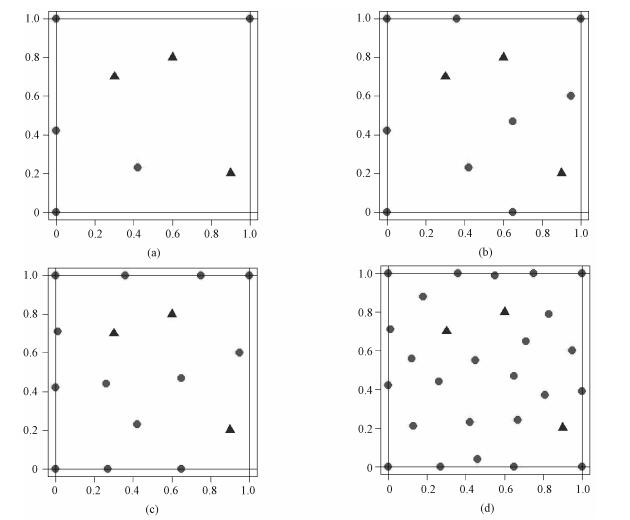
 , 杨建奎1
, 杨建奎1 1. 北京邮电大学理学院, 北京 100876;
2. 中国科学院数学与系统科学研究院, 北京 100190
2017年9月29日 收稿; 2017年11月16日 收修改稿
基金项目: 国家自然科学基金(11471172,11671386)资助
通信作者: 熊世峰, E-mail:xiong@amss.ac.cn
摘要: 最大最小距离设计是计算机试验中常用的一种空间填充设计。讨论序贯最大最小距离设计的空间填充性质,证明在样本量趋于无穷时,这种序贯设计中的点在试验区域内达到稠密.
关键词: 序贯设计空间填充设计计算机试验
A space-filling property of sequential maximin distance designs
TENG Yiyang1, WU Yun2, XIONG Shifeng2

 , YANG Jiankui1
, YANG Jiankui1 1. School of Science, Beijing University of Posts and Telecommunications, Beijing 100876, China;
2. Academy of Mathmetics and Systems Science, Chinese Academy of Science Beijng 100190, China
Abstract: Maximin distance designs, as a class of space-filling designs, are commonly used in computer experiments. In this paper we discuss the space-filling properties of sequential maximin distance design. We prove that the points in such a sequential design become dense in the experimental region as the sample size goes to infinity.
Keywords: sequential designspace-filling designcomputer experiment
随着计算技术的发展,计算机仿真试验在科学与工程中的应用越来越广[1-3]。由于仿真试验通常比较耗时,因此计算机试验和传统物理试验一样,需要有效地挑选少量试验点来进行仿真[4-6]。计算机试验的设计一般采用空间填充设计[7-11],其核心思想是设计点应在试验区域内分布得尽量均匀。常用的一类空间填充设计是最大最小距离设计[10-18]。其定义如下:点
1 构造序贯最大最小距离设计在[0, 1]d, d∈Z+中,按如下规则取点:使新取的点到所有已取点的最小距离最大化。引入下列记号表示:
记前n步取的点分别为
1) 记任意两点x, y∈[0, 1]d间的距离为d(x, y)=‖x-y‖2。
2) 记任意一点x∈[0, 1]d到已选点集合Sn的距离
3) 下一步要寻找的点
按上述规则,在[0, 1]2中,依次规定取点个数画图。
图 1中,当在[0, 1]2中第1次取点时,因为此时[0, 1]2中不存在点,规定取的第1个点在正方形的中心。接下来就可以按照序贯最大最小距离设计在空间中依次取点。第2次取点时,有4个点同时满足规则,它们在正方形的4个顶点处。可以看出,按序贯最大最小距离设计取点,可以将[0, 1]2逐步填充。
Fig. 1
 | Download: JPG larger image |
| 图 1 [0, 1]2中不存在点时按序贯最大最小距离设计取点 Fig. 1 Taking points by sequential maximin distance designs when there is no point in [0, 1]2 图 1 [0, 1]2中不存在点时按序贯最大最小距离设计取点 Fig. 1 Taking points by sequential maximin distance designs when there is no point in [0, 1]2 --> | |
图 2中,一开始[0, 1]2中已经取了3个点,这3个点用三角形表示,再按序贯最大最小距离设计取点,取得的点用圆形表示。可以看出,这种情况下序贯最大最小距离设计也可以对[0, 1]2进行逐步填充。
Fig. 2
 | Download: JPG larger image |
| 图 2 [0, 1]2中存在3个点时按序贯最大最小距离设计取点 Fig. 2 Taking points by sequential maximin distance designs when there are 3 points in [0, 1]2 图 2 [0, 1]2中存在3个点时按序贯最大最小距离设计取点 Fig. 2 Taking points by sequential maximin distance designs when there are 3 points in [0, 1]2 --> | |
2 主要结果及证明从第1节可以看出,随着样本量的增加,序贯最大最小距离设计可以对2维试验区域进行逐步填充。下面对任意的维数严格证明这一性质。
定理2.1??在[0, 1]d, d∈Z+中,按序贯最大最小距离设计取点,设所取得的点依次为
证明??反证方向为:存在ε>0,存在一个x0∈[0, 1]d,对任意的N1>0,都存在一个N2>N1,有d(x0, SN2)≥ε。
继续使用第1节中的符号。根据取点方式:
则有
| $\begin{array}{l}{q_{n + 1}} = \mathop {{\rm{max}}}\limits_{x \in {{\left[ {0, 1} \right]}^d}} \{ d(x, {S_{n + 1}})\} \\ = \mathop {{\rm{max}}}\limits_{x \in {{\left[ {0, 1} \right]}^d}} {\rm{ }}\{ \mathop {{\rm{min}}}\limits_{{s_i} \in {S_{n + 1}}} d(x, {S_{n + 1}})\} \\ = \mathop {{\rm{max}}}\limits_{x \in {{\left[ {0, 1} \right]}^d}} {\rm{ }}\{ \mathop {{\rm{min}}}\limits_{{s_i} \in {S_n}} \{ {\rm{min}}d(x, {S_n}), d(x, {s_{n + 1}})\} \} \\ \le \mathop {{\rm{max}}}\limits_{x \in {{\left[ {0, 1} \right]}^d}} \{ d(x, {S_n})\} = {q_n}.\end{array}$ |
由反证法假设,存在ε>0,存在一个x0∈[0, 1]d,对任意的N1>0,都存在一个N2>N1,有d(x0, SN2)≥ε,则
即存在ε>0,对任意的N1>0,都存在一个N2>N1,使得qN2≥ε>0,且{qn}n=1, 2, …单调递减,故可以得a≥ε>0。
下面证明对于任意已取得的点
已知
对于反证条件中任意的N1>0,取
但由于在空间[0, 1]d中,任意两点间的最大距离不超过d1/2,故每个球的半径应满足
| $\frac{a}{2} \le \frac{{{d^{1/2}}}}{2},$ |
| ${V_{{\rm{qiu}}}} < {(1 + {d^{1/2}})^d}, $ |
故原假设不成立,即我们证明了:对任意ε>0,任意x∈[0, 1]d,都存在一个N>0,当n>N时,均有d(x, Sn) < ε。即按序贯最大最小距离设计多次取点,可以填充空间[0, 1]d。
注1??上面证明的是[0, 1]d中一开始没有取任何点时,按照序贯最大最小距离设计取点,可将[0, 1]d填充。这个时候第1个点放在空间的中心,第2个点就应该取在空间[0, 1]d的一个顶点处。
若[0, 1]d中一开始存在k个点
注2 ??上述定理证明的是序贯最大最小距离设计对[0, 1]d的填充性,同样地,对任一d维紧集,在空间中一开始已经取了点和没取点两种情况下,仍能证明按序贯最大最小距离设计取点可将空间填充。
参考文献
| [1] | Morris M D, Mitchell T J, Ylvisaker D. Bayesian design and analysis of computer experiments:use of derivatives in surface prediction[J]. Technometrics, 1993, 35(3): 243-255. DOI:10.1080/00401706.1993.10485320 |
| [2] | Morris M D. A class of three-level experimental designs for response surface modeling[J]. Technometrics, 2000, 42(2): 111-121. DOI:10.1080/00401706.2000.10485990 |
| [3] | Moore L M, Mckay M D, Campbell K S. Combined array experiment design[J]. Reliability Engineering and System Safety, 2006, 91(10/11): 1281-1289. |
| [4] | Lehman J S, Santner T J, Notz W I. Designing computer experiments to determine robust control variables[J]. Statistica Sinica, 2004, 14(2): 571-590. |
| [5] | Mu W Y, Xiong S F. On algorithmic construction of maxmin distance designs[J]. Communications in Statistics-Simulation and Computation, 2016, 11(1): 1-14. |
| [6] | Santner T J, Williams B J, Notz W I. The design and analysis of computer experiments[M]. New York: Springer, 2003: 138. |
| [7] | Tang B X. A theorem for selecting oa-based latin hypercubes using a distance criterion[J]. Communication in Statistics-Theory and Methods, 2007, 23(7): 2047-2058. |
| [8] | Crombecq K, Dheane T. Generating sequential space-filling designs using genetic algorithms and Monte Carlo methods[C]//International Conference on Simulated Evolution and Learning, 2010, 6457: 80-84. |
| [9] | Dobriban E, Fortney K. Space-filling properties of good lattice point sets[J]. Biometrika, 2015, 124(4): 959-966. |
| [10] | Zhou Y D, Xu H. Space-filling fractional factorial designs[J]. Journel of the American Statistical Association, 2014, 109(507): 1134-1144. DOI:10.1080/01621459.2013.873367 |
| [11] | Wahl F, Mercadier C, Helbert C. A standardized distance-based index to assess the quality of space-filling designs[J]. Statistics & Computing, 2017, 27(2): 319-329. |
| [12] | Johnson M, Moore L, Ylvisaker D. Minimax and maximin distance design[J]. Journal of Statistical Planning and Inference, 1990, 24(2): 131-148. |
| [13] | Li Z, Nakayama S. Maximin distance-lattice hypercube design for computer experiment based on genetic algorithm[C]//International Conferences on Info-tech and Info-net, 2001, 2: 814-819. |
| [14] | Marengo E, Todeschini R. A new algorithm for optimal, distance-based experimental design[J]. Chemometrics and Intelligent Laboratory Systems, 1992, 16(1): 37-44. DOI:10.1016/0169-7439(92)80076-G |
| [15] | Coetzer R L J, Roseouw R F, Le Roux N J. Efficient maximin distance designs for experiments in mixtures[J]. Journal of Applied Statistics, 2012, 39(9): 1939-1951. DOI:10.1080/02664763.2012.697131 |
| [16] | Xia Y, Cai T, Cai T T. Maximum Projection Designs for computer experiments[J]. Biometrika, 2015, 102(2): 371-380. DOI:10.1093/biomet/asv002 |
| [17] | Li K, Jiang B, Ai M. Sliced space-filling designs with different levels of two-dimensional uniformity[J]. Journal of Statistical Planning & Inference, 2015, 157-158: 90-99. |
| [18] | Long T, Wu D, Guo X, et al. A deterministic sequential maximin Latin hypercube design method using successive local enumeration for metamodel-based optimization[J]. Engineering Optimization, 2016, 48(6): 1019-1036. DOI:10.1080/0305215X.2015.1081518 |
| [19] | Duan W, Ankenman B E, Sanchez S M, et al. Sliced full factorial-based latin hypercube designs as a framework for a batch sequential design algorithm[J]. Technometrics, 2017, 59(1): 1-39. DOI:10.1080/00401706.2015.1105759 |
